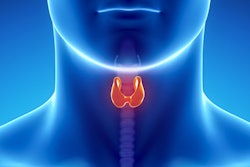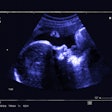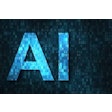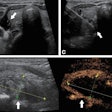Ultrasonic features are tied to an increased risk of tumor progression in patients with papillary thyroid microcarcinoma undergoing active surveillance, a South Korean study published October 31 in Radiology found.
Researchers led by Ji Ye Lee, MD, from Seoul National University Hospital found that ultrasound features of diffuse thyroid disease and intratumoral vascularity, along with other patient characteristics, are significantly associated with this thyroid cancer.
“Prediction incorporating ultrasound features may help personalize surveillance strategies in the future,” Lee and colleagues wrote.
Active surveillance is an accepted strategy in cases of low-risk papillary thyroid microcarcinoma. However, the researchers noted that there is debate on whether ultrasound features have any prognostic relevance in this area. Exacerbating this are previous studies investigating this, which have produced inconsistent results.
 Progression of hypervascular tumor with lymph node metastasis in a 64-year-old male participant with papillary thyroid microcarcinoma. (A-C) Baseline ultrasound images. (A) Transverse gray-scale image shows a solid hypoechoic thyroid nodule (arrow) with a maximal diameter of 7 mm. (B) Color Doppler image shows hypervascularity, represented by increased vascularity above that of normal thyroid parenchyma (arrows). (C) Transverse gray-scale image shows a small, probably benign lymph node at left level IV (arrow). (D) Transverse ultrasound image at 12-month follow-up demonstrates a suspicious lymph node (arrow) with increased shortest diameter and punctate echogenic foci (arrowhead). Subsequent fine-needle aspiration for this level IV lymph node revealed a metastatic thyroid papillary carcinoma. Image courtesy of Radiology.
Progression of hypervascular tumor with lymph node metastasis in a 64-year-old male participant with papillary thyroid microcarcinoma. (A-C) Baseline ultrasound images. (A) Transverse gray-scale image shows a solid hypoechoic thyroid nodule (arrow) with a maximal diameter of 7 mm. (B) Color Doppler image shows hypervascularity, represented by increased vascularity above that of normal thyroid parenchyma (arrows). (C) Transverse gray-scale image shows a small, probably benign lymph node at left level IV (arrow). (D) Transverse ultrasound image at 12-month follow-up demonstrates a suspicious lymph node (arrow) with increased shortest diameter and punctate echogenic foci (arrowhead). Subsequent fine-needle aspiration for this level IV lymph node revealed a metastatic thyroid papillary carcinoma. Image courtesy of Radiology.
Lee and co-authors investigated whether ultrasound features could help predict tumor progression in patients with low-risk papillary thyroid microcarcinoma who are undergoing active surveillance.
They included data from 699 patients from three hospitals between 2016 and 2021. The patients were self-assigned to either immediate surgery or active surveillance. Patients with two or more ultrasound exams in the absence of surgery were included in the study. Of the total, 68 patients showed tumor progression, with a median follow-up of 41.4 months.
The team found significant associations between the ultrasound features of diffuse thyroid disease and intratumoral vascularity and tumor progression. It also reported associations between other patient characteristics and tumor progression, represented by hazard ratio (HR) values.
| Characteristic |
Hazard ratio |
p-value |
|---|---|---|
| Diffuse thyroid disease |
2.3 |
0.001 |
| Intratumoral vascularity |
1.7 |
0.04 |
| Male sex |
2.8 |
< 0.001 |
| Age younger than 30 years |
2.9 |
0.01 |
| Thyroid-stimulating hormone level of 7 μU/mL or higher |
6.9 |
< 0.001 |
The researchers also found that patients with diffuse thyroid disease (14%, p = 0.001) or intratumoral vascularity (14%, p = 0.02) had a significantly higher risk of tumor progression than patients without these ultrasound features (6%).
Finally, they reported significant ties between both ultrasound features and tumor enlargement (HR = 2.7, p = 0.002), as well as new lymph node metastasis (HR = 5, P = 0.02).
The study authors suggested that based on their findings, diffuse thyroid disease and tumor vascularity should be assessed on ultrasound scans in patients undergoing active surveillance, along with tumor characteristics.
“A robust model that accurately predicts progression could be used to help stratify surveillance protocols, and could reduce patient anxiety, enhance cost-effectiveness, and potentially allow for wider adoption of active surveillance,” they wrote.
In an accompanying editorial, Karen Reuter, MD, from Tufts University in Massachusetts wrote that the study is "an excellent addition to our radiology literature," adding that it supports the American College of Radiology's goal of decreasing the number of unnecessary thyroid nodule biopsies.
"The study also provides insight into the best follow-up plan for papillary thyroid microcarcinomas>, which have shown increasing incidence worldwide," Reuter wrote. "The study demonstrated the positive value of Doppler-based evaluation of papillary thyroid microcarcinomas, raising the question of the potential value of future alterations to TI-RADS guidelines."
The full study can be found here.



















